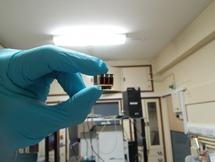Solar cells turned into cheap printable lasers
04 Apr 2014
A relatively new type of solar cell based on a perovskite material has been pioneered by Oxford University researchers led by Professor Henry Snaith.
 | |
| A perovskite solar cell made in an Oxford lab. |
Perovskite solar cells, which promise to be cheap and easy to mass produce, have already achieved a 17 per cent efficiency at turning sunlight into electric energy after a mere two years of research – potentially transforming prospects for cheap large-area solar energy generation.
In a new study, researchers from Professor Sir Richard Friend's group at Cambridge's Cavendish Laboratory working with Professor Snaith's group at Oxford have demonstrated that, by sandwiching a thin layer of the lead halide perovskite between two mirrors, it is possible to create an optically driven laser which proves these cells ''show very efficient luminescence'' - with up to 70 per cent of absorbed light re-emitted, turning them into cheap lasers. A report of the research is published in the Journal of Physical Chemistry Letters.
"This first demonstration of lasing in these cheap solution-processed semiconductors opens up a range of new applications," said lead author Dr Felix Deschler of the Cavendish Laboratory. "Our findings demonstrate potential uses for this material in telecommunications and for light emitting devices."
Most commercial solar cell materials need expensive processing to achieve a very low level of impurities before they show good luminescence and performance. Surprisingly, these new materials work well even when very simply prepared as thin films using cheap scalable solution processing.
The researchers found that upon light absorption in the perovskite two charges (electron and hole) are formed very quickly - within 1 picosecond - but then take anywhere up to a few microseconds to recombine.
This is long enough for chemical defects to have ceased the light emission in most other semiconductors, such as silicon or gallium arsenide. "These long carrier lifetimes together with exceptionally high luminescence are unprecedented in such simply prepared inorganic semiconductors," said Dr Sam Stranks, co-author from the Oxford University team.
"This luminescent behaviour is an excellent test for solar cell performance – poorer luminescence (as in amorphous silicon solar cells) reduces both the quantum efficiency (current collected) and also the cell voltage," said Professor Snaith.
Scientists say that this new paper sets expectations for yet higher solar cell performance from this class of perovskite semiconductors.
Solar cells are being scaled up for commercial deployment by the Oxford University spin-out, Oxford PV Ltd.
The efficient luminescence itself may lead to other exciting applications with much broader commercial prospects – a big challenge that the Oxford and Cambridge teams have identified is to construct an electrically driven laser.













.jpg)






.jpg)









